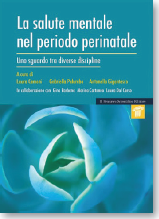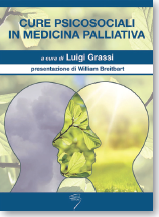BOOK REVIEWS, NOTES AND COMMENTS

LA SALUTE MENTALE NEL PERIODO PERINATALE
Uno sguardo tra diverse discipline
Laura Camoni, Gabriella Palumbo, Antonella Gigantesco (Eds).
Roma: Il Pensiero Scientifico Editore; 2022.
440 p.
ISBN: 9788849007428
€ 40,00.
[Perinatal mental health: multidisciplinarity as a resource]
Perinatal depression should be considered a public health problem due to its significant prevalence worldwide, in middle- and high-income countries as well as low-income countries [1]. Economic indices, such as the social support network, are associated with the increase in this disorder as can be seen from Italian data thanks to the “surveillance” network promoted by the Istituto Superiore di Sanità (Italian National Institute of Health) [2]. In the years 2019-2022, the percentage of women screened positive for perinatal depression increased by 14 points, from 11.6% in 2019 to 25.5% in the period between November 2021 and April 2022. Such high percentages leave no doubt about the need and priorities to extend screening programs and to have interventions that are effective at the same time to promote a good mother-child relationship and improve the psychological well-being of the future mother as soon as possible, with particular attention to the “family emotional climate”. When writing about mother-child relationship it means focusing attention on the relationship already existing during pregnancy since a depressive state, and sometimes the coping mechanisms are not only ineffective but counterproductive (think of the possible use of alcohol to soothe suffering or help sleep), greatly interfere with the state of health of the unborn child as has been known for some time now [3, 4]. Improving the psychological state of the mother, and of family relationships, therefore also means intervening to promote health and prevent any psychopathological problems in the child.
The work of Camoni, Palumbo and Gigantesco (in collaboration with Gina Barbano, Marina Cattaneo, Laura Dal Corso) is characterized as a working tool that responds to the complex problem of this disorder and does so both by clarifying the cultural aspects in depth with a multidisciplinary structure and by providing evidence-based recommendations. For this last aspect, consider the presentation of the work by Professor Jeannette Milgrom, of the Department of Clinical and Health Psychology and Parent-Infant Research Institute (PIRI) of Melbourne University, a pioneer and one of the leading international experts. The book thus originates from a systematic collection of the most prestigious Italian experiences in this sector of health services, universities, and the twenty-year commitment of the researchers of the Istituto Superiore di Sanità also thanks to the provident and visionary Morosini, an innovator in the field of evaluative epidemiology and public health. With a multidisciplinary structure, the various chapters range from anthropology to psychobiology, from genetics to information technology, from suicidology to attachment theory, from psychopathology to economics, and from before conception to the return to working life, thus crossing the perinatal and postpartum periods.
In the first part “Towards parenthood” the themes of the influence that nature, culture, mass media, and stereotyped representations have on the maternal and paternal parental identity are explored. The mother-child and father-child relationship are thus accurately described, from the point of view of attachment theory as well as the difficulties and dangers inherent in the couple when it becomes a family and finally, the relationship between maternal perinatal depression and personality structures. Particular attention is also given to the description of the functioning of same-parent families and the formation of parenting in the aspects relating to the unconscious construction of the parental function relating to sexual orientation, gender identity and the biological or non-biological link with the son.
In the second part “The period of pregnancy”, the issues of prenatal attachment are addressed as well as how the mother builds a representation of the child based on sensory and visceral experience. The important recent epidemiological evidence is therefore presented concerning: a) the repercussions that stress and the presence of anxiety or depressive disorders in the mother can have on the mental health of the unborn child; b) the possible biological mechanisms involved in fetal programming and long-term outcomes, including the most current studies on epigenetic mediation; c) the diffusion of depressive and anxiety disorders in the perinatal period, the importance of early screening and treatment of depression in the perinatal period to obtain better health outcomes for the mother, the child and the family unit. The session concludes with the delicate topic of traumatic experiences during childbirth, which can be associated with more severe clinical phenotypes of perinatal depression and reduced levels of resilience.
The third part “The post-partum and the first two years after childbirth” deals with the theme of resilience understood as a continuous process of personal growth, the adoption of efficient emotional regulation strategies, adaptation and the search for family balance and well-being, also useful for overcoming the vulnerability and daily challenges that pregnancy and postpartum entail. The psychological, genetic and environmental factors that characterize the aetiology of mental disorders in the perinatal period are examined and the theme of violence that takes place within the home, suicide, infanticide and finally, more generally, mourning.
The fourth part “Parenthood and return to work” deals with the topic, sometimes neglected but very relevant, of returning to work after maternity leave and the new technological opportunities to support women by protecting their individual and organizational well-being.
In the fifth part “Taking care of mental health in the perinatal period” there is a broad examination of the treatment of anxiety and depression in the perinatal period from the perspective of the different theoretical approaches (cognitive-behavioural, psychodynamic, psychoeducational both individual and couple, family and group). Updated information on web-based approaches and the use of new technological resources is also provided.
The last part of the volume “An intervention program of proven effectiveness in the practice of national health services in Italy” explores, in particular, the issues being studied by the Istituto Superiore di Sanità. Specifically, it describes a process of taking charge of women with mental health problems in the perinatal period starting from the screening, to continuing with the assessment and the intervention for which efficacy has been demonstrated in practice in Italian services. Finally, ample space is given to a review of the main guidelines on perinatal mental health and the consequences of the economic impact when the problem of the affected parent extends to the family context and especially to the children.
In my opinion, it is a wide-ranging work, which provides the reader interested in really knowing the topic of perinatal mental health going beyond its more usual declinations, an all-round overview of this discipline still in a dynamic evolution.
Franco Veltro
Associazione Italiana per la Diffusione
degli Interventi Psicoeducativi in Salute Mentale (AIDIPSaM – APS)
REFERENCES
- 1. Kariuki SM, Newton CRJC. The importance of perinatal maternal depression as a public health problem in Africa. Lancet Psychiatry. 2022 Jul;9(7):527-8. doi: 10.1016/S2215-0366(22)00197-3.
- 2. Camoni L, Mirabella F, Gigantesco A, Brescianini S, Ferri M, Palumbo G, Calamandrei G on behalf of the Perinatal Mental Health Network. The Impact of the COVID-19 pandemic on women’s perinatal mental health: preliminary data on the risk of perinatal depression/anxiety from a national survey in Italy. Int J Environ Res Public Health. 2022;19:14822. doi: https://doi.org/10.3390/ijerph192214822
- 3. Kingston D, Tough S, Whitfeld H. Prenatal and postpartum maternal psychological distress and infant development: a systematic review. Child Psychiatry Hum Dev. 2012;43:683-714.
- 4. Waters CS, Hay DF, Simmonds JR, van Goozen SH. Antenatal depression and children’s developmental outcomes: potential mechanisms and treatment options. Eur Child Adolesc Psychiatry. 2014;23:957-71.

CURE PSICOSOCIALI IN MEDICINA PALLIATIVA
Edited by Luigi Grassi
Milano: Poletto Editore; 2021
256 p.
ISBN: 9788895033921
€ 55,00
[Psycho-social care in palliative medicine]
Palliative care as such is not a discipline but a collection of disciplines including psychology, communication, ethics, and psycho-social rehabilitation that require considerable training and empathy on the part of healthcare professionals.
In such delicate area as palliative care, this publication explores the multiple and pressing needs that must be addressed correctly and competently. This book offers an overview of general aspects, fundamental principles and alleviation in advanced stages of disease and end-of-life situations; it also explores communication and relational strategies, as well as existential and spiritual needs, with a focus on psychological and psychosocial aspects alongside analysis of psychiatric disorders in palliative medicine. An extremely interesting and useful section for professionals discusses psychotherapy intervention with families and the team. The volume closes with special topics such as palliative sedation, suicide, medically assisted euthanasia, pediatric palliative care and alleviation in chronic and degenerative pathologies. On the whole, this book brings together contributions by highly experienced authors and therefore covers the various aspects of emotional, cognitive and behavioral needs that are encountered when facing a palliative care programme.
The same publishing house in 2019 published another book on the subject which is worth mentioning here: The Italian book of medicine and palliative care [1]. This is intended for all professionals interested to learn more about this discipline, and to those who already have experience in the field and can use it as a useful source of references and updates.
Anna De Santi
Dipartimento di Neuroscienze
Istituto Superiore di Sanità, Rome, Italy
